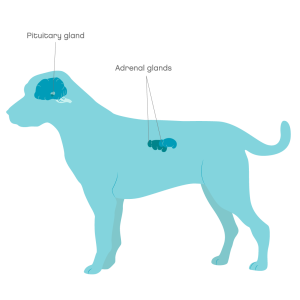Cushing’s syndrome is a disease caused by high levels of the hormone cortisol. It’s the most common hormonal disease in dogs. It affects many organs and body functions. In older dogs, Cushing’s disease may be due to cancer.
Cushing’s syndrome, or hyperadrenocorticism, is caused by excessive levels of cortisol in the blood, disrupting normal metabolism. This causes many problems, such as increased risk of some infections and diabetes. Treatment is effective at improving quality of life and reducing complications, but is lifelong and requires frequent monitoring.
A similar disease can happen in dogs that have been on treatment with very high doses of steroids for a long time, but this can be solved by slowly reducing the treatment dose. This must always be done under close monitoring by a vet.
Overview
What is Cushing’s Syndrome in Dogs?
A growth or cyst in one of two organs, the pituitary gland (near the brain) or the adrenal glands (near the kidneys) causes increased levels of cortisol, which is involved in many different functions in the body. This growth can sometimes be cancerous.
Life expectancy in untreated dogs is 6-18 months, and this can be worse if the growth is cancerous or starts affecting the brain. Quality of life can be seriously affected.
Affects middle-aged and older dogs. This is a serious and chronic condition.

Symptoms
Symptoms of Cushing’s syndrome
Symptoms of Cushing’s disease are varied due to the effects of cortisol on many organs.
Excessive drinking and urination are very common, this may lead to toileting accidents in the house.
Increased appetite is very common.
Hair loss and repeated skin infections are frequent, black spots can sometimes be seen on the skin.
Some dogs will develop a pot-bellied appearance.
Muscles can become weaker and exercising difficult.
Panting can be excessive, even at rest.
Changes in behaviour or seizures can happen if the brain becomes affected.
Risk
Dogs at higher risk of developing Cushing’s disease
Pituitary tumours, the most common type, are more common in small dogs, especially terriers, dachshunds, and poodles.
Adrenal tumours are more common in older large dogs, especially females.
Diagnosis
How is Cushing’s syndrome diagnosed?
Hormone levels are affected by other diseases and normal body functions. It can be difficult to reach a definitive diagnosis and a combination of symptoms and tests is required.
A urine test to detect the overproduction of urine and secondary bacterial infections is important. A urine cortisol/creatinine ratio can be useful in some cases.
Blood tests are used to check the function of the most important organs.
The adrenocorticotropic hormone (ACTH) suppression test can be used to investigate if a dog has Cushing’s disease.
The low-dose dexamethasone suppression test can be used to confirm a diagnosis of Cushing’s disease and provide some clues as to which organ is the source of the problem.
If an adrenal tumour is suspected, an ultrasound may help confirm this.
If a pituitary tumour is suspected, an MRI may confirm this, but these tumours are very small and only detectable 50% of the time.
Vet treatment
What is the treatment for Cushing’s syndrome?
Trilostane (Vetoryl) tablets are the most common treatment for Cushing’s disease. It works by blocking some of the production of cortisol. Frequent monitoring is needed as hormone levels may change over time.
Surgery is a treatment option for adrenal tumours. There is a significant risk of complications and intensive care is needed for several days.
Surgery is also possible for some pituitary tumours, but this is only done in a few hospitals and complications are serious and common.
Mitotane is used for chemotherapy when tumours are present. It’s not commonly used due to its potential side effects.
Home treatment
Living with a dog with Cushing’s syndrome
Dogs that respond well to treatment will have a normal life, apart from regular vet visits (every 3-6 months when stable, a blood test is often recommended) and daily tablets.
Unfortunately, there are no home remedies shown to help with Cushing’s syndrome.
Cushing’s syndrome may mask symptoms from other diseases, such as urinary tract infections and osteoarthritis, and these may need to be treated as well. Call your local vet if you notice any unexpected changes after starting treatment.
Once your dog is stable, their water intake increasing again may be an early sign that the disease is getting worse. Water intake is considered normal between 20-70 ml/kg/day, but this may vary a lot depending on the water content in food, exercise, temperature, humidity, and other factors.
Sadly not all dogs respond to treatment, and in those that do, the disease is still likely to progress over time. This condition is not known to be painful, but the symptoms and complications have a major impact on quality of life. If treatment is not possible or ineffective, euthanasia may be the kindest option.
Prevention
Can I prevent Cushing’s syndrome in my dog?
Unfortunately, there is no specific way to prevent Cushing’s disease. A healthy diet and exercise help as with all other health problems.
When to worry
When should you be worried about Cushing’s syndrome complications
Initial signs that may let you know your dog needs a vet check:
- Changes in coat or skin
- Changes in appetite, drinking or urination
- Repeated infections
Seek help from a vet if:
- There is a change in your pet’s breathing or their tolerance to exercise
- They are straining to urinate or constantly want to go out
- The skin or ears become red, smelly, or patchy
- Symptoms that had improved with treatment start to return
Changes in their breathing, in particular, can be urgent. Call your vet straight away.
Joii can help with tips about giving medication, food advice or other ways to improve their general health.








